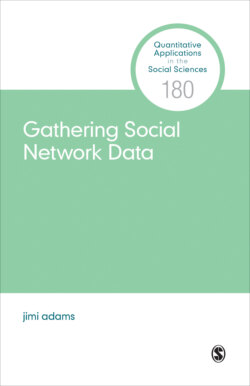Читать книгу Gathering Social Network Data - jimi adams - Страница 15
На сайте Литреса книга снята с продажи.
Longitudinal Networks
ОглавлениеThe different potential causal directions of network research reflected in the questions raised above (i.e., theories of networks and network theories) often lead people to ask how best to address temporality in network data and analyses. As with many of the necessary methodological considerations raised in this book, some elements have direct overlaps with approaches drawn from standard research methods, other elements require adaptation from these approaches, and still others solely matter for networks research. For now, I will simply note that if, for example, you are concerned with addressing questions about network theories, it is not going to be sufficient to simply be sure that the network measures precede those observations that you aim to explain. In the chapters that follow, I will address longitudinal considerations above and beyond those linked to capturing static snapshots of network data, where such temporally specific methodological considerations require unique adaptations or strategies of their own for network research.14
14 See especially the section in Chapter 3 on “Complex Networks.” As was the case in several areas mentioned above, these will assume you know and work with existing “best practices” from social research methods generally and will only focus on providing description of where network research differs from, or requires additional considerations to, these standard approaches.
Table 1.1 combines the ideas from above into a set of representative questions commonly found in networks research. The list in Table 1.1 is by no means comprehensive but covers a broad sampling from existing research questions. Before we can continue with the central aim of this book to describe methods for capturing the networks that will allow you to examine these types of research questions, we must next address the types of ties that could potentially be measured within any such study.15
15 In the chapters that follow, I draw on examples that stem from a variety of disciplinary and topical areas. However, I do not organize these sections by those areas, as most of the principles I discuss cut across those domains. As you think about the theoretical motivations for your own work, however, you may find such disciplinarily organized discussion useful. Chapter 6 in Robins (2015) provides a useful broad sketch of a number of these possibilities.
Table 1.1a
aThis table is adapted from James Moody with permission.
